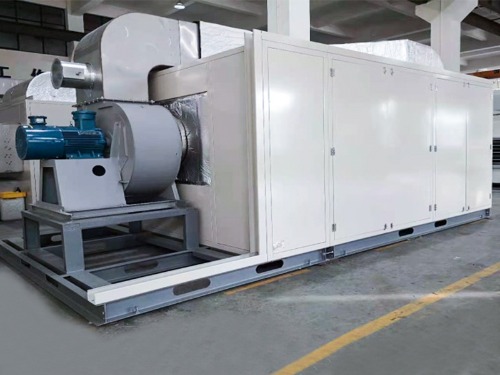Installing an NMP (N-Methyl-2-pyrrolidone) solvent recovery system typically involves several steps. However, please note that the specific installation process may vary depending on the manufacturer and the specific system you are working with. It is crucial to refer to the installation manual provided by the manufacturer for detailed instructions. Here is a general overview of the installation process:
Site Preparation: Before installing the NMP solvent recovery system, ensure that the designated area is properly prepared. This may involve clearing the space, ensuring proper ventilation, and providing necessary utilities such as electricity, water, and exhaust systems.
Equipment Placement: Carefully position the main components of the NMP solvent recovery system, including the distillation unit, condenser, solvent storage tanks, pumps, and associated piping. Ensure that there is sufficient space around each component for maintenance and access.
Connect Piping: Install and connect the necessary piping to connect the various components of the system. This may include inlet and outlet pipes, transfer lines, and venting pipes. Follow the provided schematic diagrams and ensure proper alignment and tight connections.
Electrical Connections: Connect the electrical wiring to power the system. Follow the provided electrical diagram and ensure compliance with local electrical codes and safety standards. It is advisable to consult a qualified electrician for this step if you are not experienced with electrical work.
Exhaust and Ventilation: Ensure proper exhaust and ventilation systems are in place to effectively remove any fumes, gases, or vapors generated during the solvent recovery process. Connect the exhaust ducting and verify that it meets local regulations and safety requirements.
Calibration and Testing: Once the system is properly installed, perform calibration and testing procedures as recommended by the manufacturer. This may involve adjusting pressure settings, temperature controls, and flow rates to ensure optimal performance.
Safety Measures: Install any necessary safety features and equipment, such as emergency shut-off valves, fire suppression systems, and appropriate labeling and signage. Familiarize yourself with the system's safety protocols and procedures.
Training and Commissioning: Ensure that the personnel responsible for operating the NMP solvent recovery system receive proper training from the manufacturer or an authorized representative. Perform a thorough commissioning process to verify that the system is functioning correctly and meeting performance specifications.
Ongoing Maintenance: Establish a regular maintenance schedule to keep the NMP solvent recovery system in optimal condition. This may include routine inspections, cleaning, filter replacement, and periodic equipment servicing.
Compliance and Regulations: Ensure that the installation and operation of the NMP solvent recovery system comply with applicable local, state, and federal regulations. This may include obtaining necessary permits and approvals.
It is important to note that the installation of an NMP solvent recovery system may require specialized knowledge and expertise. If you are not familiar with the process or feel unsure about any aspect of the installation, it is recommended to consult with a professional installer or contact the manufacturer for guidance and support.Besides,The working principle of an NMP (N-Methyl-2-pyrrolidone) solvent recovery system involves the separation and purification of NMP solvent from various waste streams, allowing for its reuse or proper disposal. The system typically consists of several key components, including a distillation unit, condenser, solvent storage tanks, pumps, and associated piping. Here's a general overview of the working principle:
Feed Stream Introduction: The NMP solvent recovery system receives a feed stream that contains a mixture of NMP solvent and impurities or contaminants. This feed stream can come from various sources, such as industrial processes or waste streams.
Distillation Process: The feed stream is introduced into the distillation unit. Inside the distillation column, the feed stream is heated to its boiling point, causing the NMP solvent to vaporize. The impurities and contaminants have higher boiling points and remain in the liquid phase.
Separation of Vapors: As the feed stream is heated, the vaporized NMP solvent rises through the distillation column. The column is equipped with trays or packing material that helps to create a larger surface area for efficient separation. The rising vapors move upward while undergoing repeated condensation and vaporization stages.
Condensation and Cooling: The vaporized NMP solvent moves into the condenser, where it is cooled. The cooling process causes the NMP solvent vapor to condense back into a liquid state. The condenser may use water or another cooling medium to facilitate the condensation process.
Collection and Storage: The condensed NMP solvent is collected in solvent storage tanks. These tanks are designed to safely store and maintain the recovered solvent until it is reused or properly disposed of, depending on the intended application.
Impurity Disposal: The liquid residue left behind in the distillation unit, which contains the impurities and contaminants with higher boiling points, is either collected for appropriate disposal or subjected to further treatment if required by regulations.
Recirculation or Reuse: Depending on the specific application and requirements, the recovered NMP solvent can be recirculated back into the process where it is being used, reducing the need for fresh solvent. Alternatively, it can be reused in other suitable applications.
Control and Monitoring: The NMP solvent recovery system is equipped with controls and monitoring devices to ensure efficient operation and safety. These may include temperature sensors, pressure gauges, level indicators, and automated systems to regulate the distillation process.
Maintenance and Optimization: Regular maintenance and optimization of the NMP solvent recovery system are necessary to ensure optimal performance. This includes cleaning, inspection, and calibration of the system components, as well as periodic replacement of filters and other consumables.
It's important to note that the specific working principles and configurations of NMP solvent recovery systems can vary depending on the design and manufacturer. It's recommended to refer to the system's operation manual or consult with the manufacturer for detailed instructions and guidelines specific to the equipment you are working with.





 English
English 简体中文
简体中文